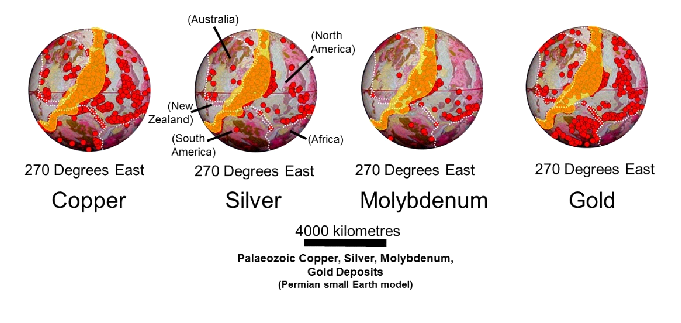


It seems that just like buses, new science papers discussing the expanding Earth theory are arriving together. After two recent papers discussing some of the detailed geological evidence indicating Earth expansion (see related pages below), James Maxlow has just released an important new paper, Modelling Modern Global Geodata on an Ancient Earth.
The main point highlighted in Maxlow’s new paper is the predictability of Expansion Tectonics (as Maxlow calls his expanding Earth research) compared to Plate Tectonics. He notes that “conventional plate tectonics considers that continental and seafloor crustal development has been a random, non-predictive, and somewhat catastrophic process”. Although Maxlow doesn’t mention it, he is referring to hypotheses like the well-known Wilson Cycle, were the ancient continental plates break apart, reform and then break apart again in endless cycles on a constant diameter Earth. These non-predictive processes are well-known to students of Plate Tectonics.
In complete contrast to this non-predictive process, Maxlow explains in detail how Expansion Tectonics is,
The main point highlighted in Maxlow’s new paper is the predictability of Expansion Tectonics (as Maxlow calls his expanding Earth research) compared to Plate Tectonics. He notes that “conventional plate tectonics considers that continental and seafloor crustal development has been a random, non-predictive, and somewhat catastrophic process”. Although Maxlow doesn’t mention it, he is referring to hypotheses like the well-known Wilson Cycle, were the ancient continental plates break apart, reform and then break apart again in endless cycles on a constant diameter Earth. These non-predictive processes are well-known to students of Plate Tectonics.
In complete contrast to this non-predictive process, Maxlow explains in detail how Expansion Tectonics is,
“progressive, predictive, and evolutionary. All diametrically opposed ancient magnetic north and south poles are precisely located, and the established poles and equator coincide fully with observed climate zonation and plant and animal species development. Plant and animal species evolution is shown to be intimately related to continental development, the distribution of ancient continental seas, formation of the modern continents and oceans, and subsequent changes to climate zonation.”
Perhaps one of the most important practicable applications for this new knowledge is the distribution of natural resources. The global position of Metal, Coal, Petroleum and Natural Gas can all be more precisely predicted using Expansion Tectonics. These sorts of predictions are highly valuable to mining industries since it will save the companies millions if they can accurately predict where to look for natural resources.
Expansion Tectonics is, “progressive, predictive, and evolutionary”
Share this page
After reprisal of his reconstructions for those not already familiar with Maxlow’s research, we are presented with the data and maps for Metallogeny and Fossil Fuels. Maxlow explains how,
“data and settings are essentially the same as those identified within conventional studies. The difference being that, on an increasing radius Earth, prior to the early-Triassic Period, all continental crusts were assembled together on a smaller radius supercontinental Earth. The small Earth assemblages then enable pre-Triassic metallogenic provinces from otherwise remote locations to be assembled together as unique, inter-related provinces on smaller radius Earth models. The assemblage of continents and crustal elements on small Earth models then provides a means to investigate the spatial and temporal distribution of metals across adjoining continents and crustal regimes. Recognition and understanding of past metal distributions on the present-day Earth then potentially enables mineral search and genetic relationships to be extended beyond their known type localities.”
Here is a concrete test of the validity of Expansion Tectonics. Are these predictions confirmed? This is the ultimate test of any theory.
Comment on this page
Related Pages
Australian Institute of Geoscientists - Earth expansion
How did life migrate across the ancient Pacific?
The Concept of Gondwanaland and Pangaea
Main Evidence for the Expanding Earth theory
A Brief History of the Expanding Earth theory
An index of Interesting Publications
Latest News, Comments and Updates
How did life migrate across the ancient Pacific?
The Concept of Gondwanaland and Pangaea
Main Evidence for the Expanding Earth theory
A Brief History of the Expanding Earth theory
An index of Interesting Publications
Latest News, Comments and Updates
References
Maxlow, J. (2016). Modelling Modern Global Geodata on the Ancient Earth. Free pdf
Maxlow, J. (2014). On the Origin of Continents and Oceans: A Paradigm Shift in Understanding
Book details Review (pdf)
See James Maxlow’s web site for additional reconstructions
http://www.expansiontectonics.com/index1.html
Maxlow, J. (2014). On the Origin of Continents and Oceans: A Paradigm Shift in Understanding
Book details Review (pdf)
See James Maxlow’s web site for additional reconstructions
http://www.expansiontectonics.com/index1.html
Page first uploaded 21 Aug 16
Page last updated 10 Jan 17
Page last updated 10 Jan 17





